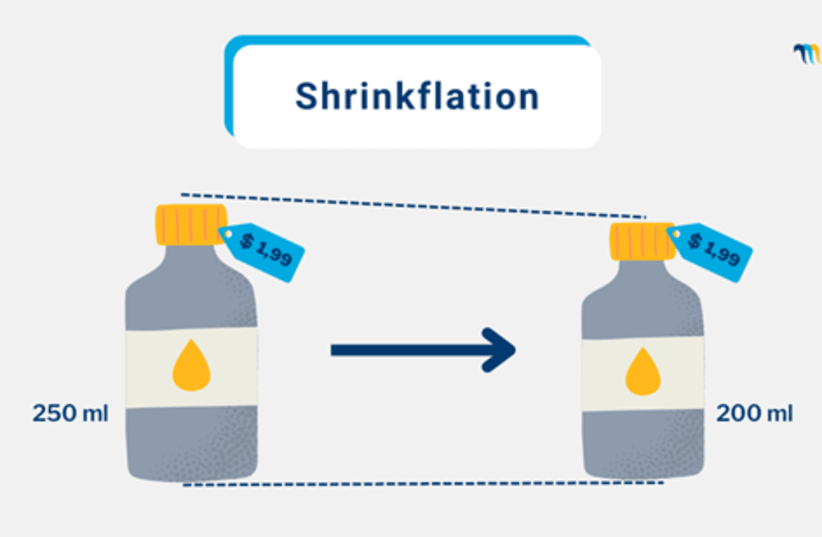According to data released by the U.S. Department of Labor, the U.S. consumer price index in October increased by 7.7% year-on-year, the smallest increase on record, which was lower than 8.2% in September and lower than 8% expected by economists. Although high inflation has become a topic of the past, the subsequent economic growth of the United States is facing challenges.
Consumers take the risk of shrinkflation, an economic phenomenon that has been common over the years and means buying products with less capacity than before at the same price. In the post-epidemic era, due to the impact of the supply chain and transportation, it is difficult for merchants to increase prices directly, so they adopt the method of shrinkflation to carefully plan to reduce the quantity of the same product while keeping the price unchanged. Generally, the brand operator will secretly change the packaging, so that the product with a new look does not look very different from the previous one.
Here are some suggestions for you to fight shrinkflation:
Pay attention to the price changes and product trends of daily necessities
If you are used to buying 600g of bread for $10 a week, but its price suddenly rises to $10.50 per pouch, and it is sold to you 500g for $10 now. Brands don’t expect buyers to notice a change in the weight of the product they buy, but for such a daily purchase, even a $0.5 increase is closely felt by customers and is likely to be rejected. Therefore, as a consumer, you need to pay close attention to the daily necessities you buy. When you encounter shrinkflation, you can choose a substitute or buy it when the product is on sale.
Choose other channels of lower price to buy
If the price of an item you are currently buying is under shrinkflation, you can choose a store such as a grocery store to buy at a lower price. Because grocery stores often have promotions, and you can choose to buy online and pick up offline. Its multi-regional stores make it convenient for you to pick up offline. Curbside pickup at some stores can also allow you to reduce your risk of infection.
Buy essentials in bulk
When shopping for daily necessities, it may be easier to save money by considering bulk purchases as a full discount than buying in small quantities. But what you need to pay attention to is not to cause excessive purchases, so that certain food items cannot be consumed after the expiration date, and in the end, the money is wasted instead of saved. If it is an item such as toilet paper or garbage bags that can be stored, purchased in bulk and has a discount. Or a product such as canned food that has a longer storage period than fresh food, it can be considered for bulk purchase.
Use coupons
Financial expert Natalie Warb says, “Everyone consumes almost every day, but how to spend rationally under the current inflation situation has become particularly important. Blind consumption and overspending will cause a financial burden. Therefore, when you are shopping, you can actually use coupons from websites like CouponBirds. They will provide you with a large number of coupons for your favorite brands, and you can save money by using them when you checkout. In addition, many coupon sites also provide corresponding extensions. You can search for them on Google. After installing extensions, when you open the shopping cart page or checkout page, the extensions will pop up prompts in time to tell you which codes are available.”
Online shopping
In the face of shrinkflation, choosing online shopping is undoubtedly the most time-saving shopping method instead of offline. You can search for the type of product you need online, quickly compare the product quality and price among several favorite online brands, and choose the product that suits you best and choose to buy it. This way is really good to save money, because time is money sometimes.
Consider different specifications
Some merchants may set different product sizes or specifications for the same product. Brands generally do not immediately adjust the packaging of all products, and may test the effect in the market by changing some packaging. So you can buy larger or smaller volume packs than what you're used to buying in product sizes for better value, rather than buying the usual size and experiencing shrinkflation.
No "famous brand"
Many consumers are accustomed to buying products of famous brands when shopping, whether it is towels, milk powder, cans, or cereals, bread, and candy. However, due to their higher marketing costs, well-known brand products may have a greater degree of shrinkflation than other affordable brands, and their prices may rise faster. Some interviews pointed out that as inflation continues, shoppers may not be obliged to remain "loyal" to famous brands. Therefore, when you face shrinkflation, you can try to avoid famous brands and choose more affordable brands to buy similar products.
Recently, there are shopping festivals such as Black Friday and Cyber Monday. Although it is an e-commerce festival, there are many online and offline stores conducting promotions, with discounts as high as 80%. If you need to purchase something during this festival, you must keep your eyes open, and plan your shopping list and budget in advance to avoid financial pressure caused by impulsive consumption, in case you will be in debt next year after your happy shopping.
